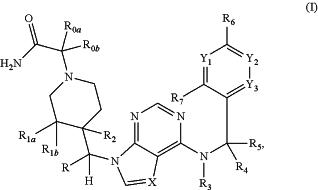| CPC C07D 473/34 (2013.01) [A61P 37/06 (2018.01); C07D 487/04 (2013.01)] | 20 Claims |
|
1. A compound according to Formula (I)
 a stereoisomer thereof, or a pharmaceutically acceptable salt of the compound or stereoisomer, wherein:
Y1, Y2 and Y3 are independently —N— or —CR8—;
X is —CR9—, or —N—;
R0a and R0b independently are selected from the group consisting of hydrogen, C1-4 alkyl, C1-4 hydroxyalkyl, and C1-4 haloalkyl;
R is selected from the group consisting of hydrogen, C1-8 alkyl and C1-4 hydroxyalkyl;
R1a and R1b are independently selected from the group consisting of hydrogen, hydroxyl, halogen, amino, C1-4 alkyl, C1-4 hydroxyalkyl, and C1-4 haloalkyl;
R2 is selected from the group consisting of hydrogen, hydroxyl, amino, cyano, halogen, C1-4 alkyl, C1-4 haloalkyl, C1-4 hydroxyalkyl, —C(═O)NH2, —C(═O)OH, —C(═O)O—C1-4 alkyl, and substituted or unsubstituted heteroaryl;
R3 is selected from the group consisting of C1-4 alkyl, C1-4 alkenyl, C1-4 haloalkyl, C1-4 hydroxyalkyl, C3-7 cycloalkyl, and C3-7 cycloalkenyl; or
R3 and R4 are taken together with the atoms to which they are attached to form a 4-6 membered heteroalicyclic ring system optionally substituted with one to three substituents selected from halogen, hydroxyl, and C1-4 alkyl;
R4 is hydrogen or C1-4 alkyl, provided R3 and R4 are not taken together with the atoms to which they are attached to form a 4-6 membered heteroalicyclic ring system; or R4 and R5 are taken together with the carbon atom to which they are attached to form a C3-4 cycloalkyl;
R5 is absent, hydrogen or C1-4 alkyl, provided that R4 and R5 are not taken together with the carbon atom to which they are attached to form a C3-4 cycloalkyl;
R6 is selected from the group consisting of hydrogen, —CN, halogen, C1-4 alkyl, C1-4 hydroxyalkyl, C1-4 haloalkyl, C1-6 hydroxyhaloalkyl, C1-4 alkoxy, C1-4 haloalkoxy, and 5-6 membered heteroaryl, wherein 5-6 membered heteroaryl is optionally substituted with C1-4 alkyl;
R7 is selected from the group consisting of hydrogen, hydroxyl, —CN, halogen, C1-4 alkyl, C1-4 haloalkyl, C1-4 hydroxyalkyl, C1-4 alkoxy, and C1-4 haloalkoxy;
each R8 is independently selected from the group consisting of hydrogen, hydroxyl, —CN, halogen, C1-4 alkyl, C1-4 haloalkyl, C1-4 alkoxy, and C1-4 haloalkoxy; and
whenever R7 is hydrogen and each R8 present is hydrogen, then R6 is selected from the group consisting of —CN, halogen, C1-4 alkyl, C1-4 haloalkyl, C1-6 hydroxyhaloalkyl, C1-4 hydroxyalkyl, C1-4 alkoxy, C1-4 haloalkoxy, and 5-6 membered heteroaryl, wherein 5-6 membered heteroaryl is optionally substituted with C1-4 alkyl;
R9 is selected from the group consisting of hydrogen, halogen, cyano, and C1-4 alkyl.
|
|
19. The compound, stereoisomer thereof, or pharmaceutically acceptable salt of the compound or stereoisomer thereof according to claim 1 and at least one pharmaceutical acceptable excipient.
|